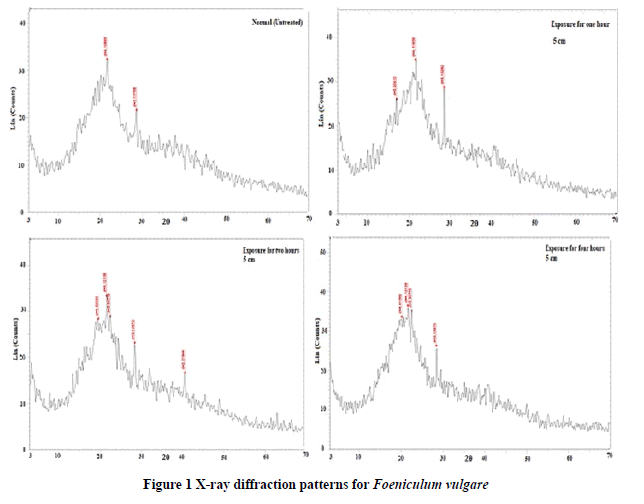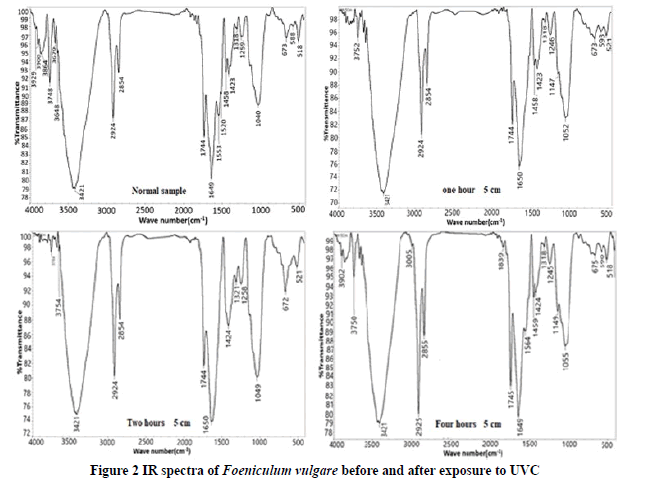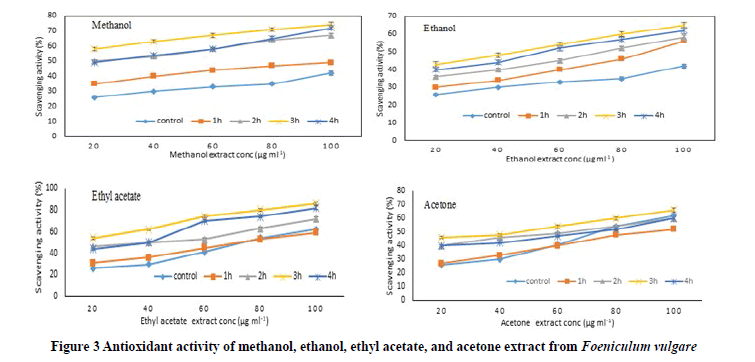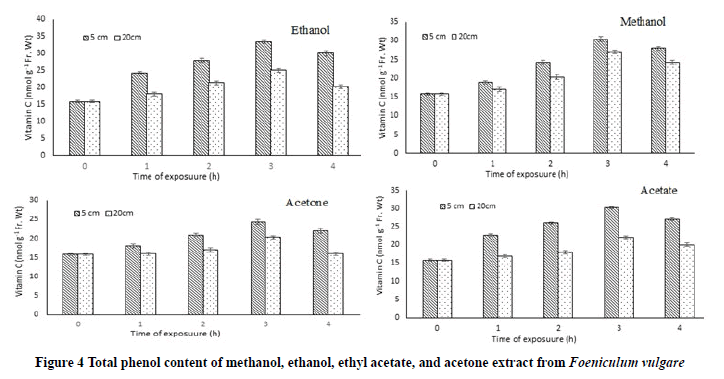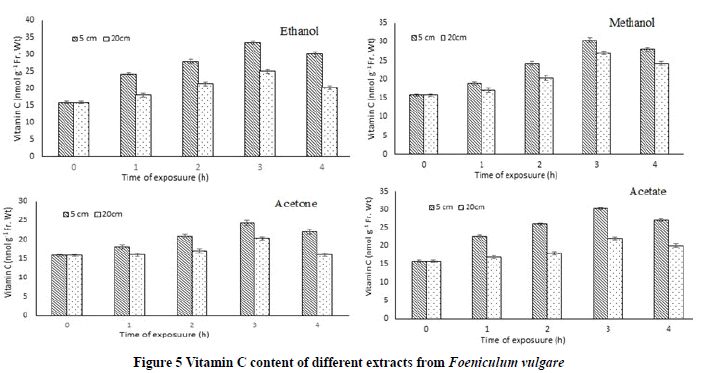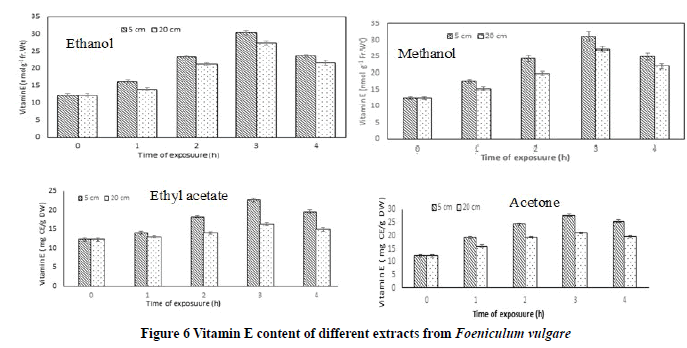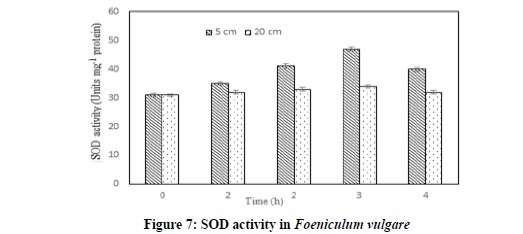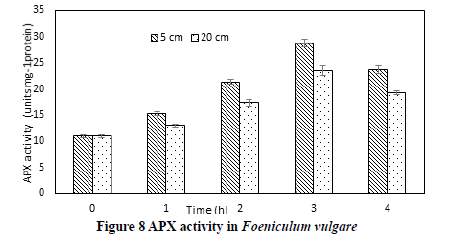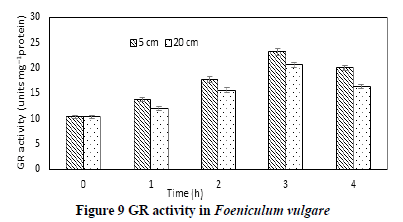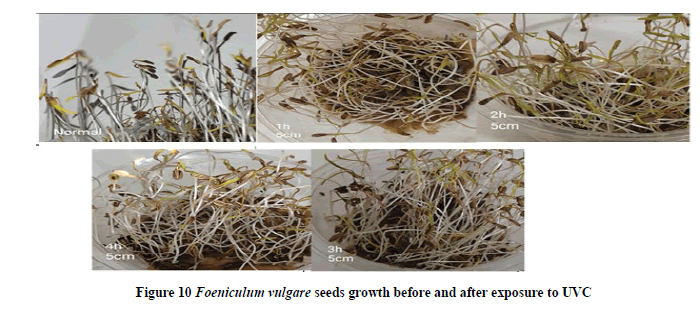Research - International Journal of Medical Research & Health Sciences ( 2021) Volume 10, Issue 6
Effect of Ultraviolet Radiation on Growth, Structure, and Bio-contents of Foeniculum vulgare
Abu Bakr El-Bediwi1*, Hager Yuns1 and Hamed M El-Shora22Botany Department, Faculty of Science, Mansoura University, Egypt
Abu Bakr El-Bediwi, Physics Department, Faculty of Science, Mansoura University, Egypt, Email: baker_elbediwi@yahoo.com
Received: 19-May-2021 Accepted Date: Jun 23, 2021 ; Published: 30-Jun-2021, DOI: 0
Abstract
Morphological traits such as growth, shape, and weight, internal structure like order and position of chemical compound and bio-contents such as enzymes, vitamins, and antioxidant activity for normal and irradiated Foeniculum vulgare were studied. The growth of Foeniculum vulgare is affected by exposure to UVC. The volumetrical shape of the Foeniculum vulgare also decreased by exposure to UVC. Continuous increase in enzyme activity, tocopherol content, vitamin C, total phenol content, and antioxidant activity for the Foeniculum vulgare by increased the exposure time to UVC up to 3 hours then declined in the fourth hour.
Keywords
Foeniculum vulgare, UVC, Molecular structure, Antioxidant activity, Phenol, Vitamins
Introduction
Foeniculum vulgare is a flowering plant species in the carrot family. F. vulgare has been reported to contain 6.3% of moisture, 9.5% protein, 10% fat, 13.4% minerals, 18.5% fiber, and 42.3% carbohydrates. Ultraviolet (UV) constituted approximately 8%-9% of total solar radiation and considers a part of non-ionizing rays of the electromagnetic spectrum region [1,2]. Plants sensitive to UV may also respond by accumulating UV absorbing compounds in their outer tissue layers, which presumably protect sensitive targets from UV damage. The key enzymes in the biosynthetic pathways of these compounds are specifically induced by UV irradiation via. gene activation [3]. UV radiation above ambient may inhibit plant growth, development, and reproduction and depress photosynthesis [4,5]. UV in the range 2800 Å-4000 Å as a small fraction of the solar radiation reaching the terrestrial ecosystems is an important modulator of plant physiology [6]. The physiological, biochemical processes, leaf chlorophyll, protein content, and peroxidase enzyme activity in plants can be affected by ultraviolet C radiation [7,8]. The effect of UVC on the germination percentage, germination rate, radicle length, and plumule length of maize and sugar beet seeds has been reported [9]. Also, UVC radiation was shown to increase the germination percentage of the groundnut [10]. Nonetheless that UVC radiation did not significantly affect the germination percentage of Acacia ampliceps seeds [11]. The influence of UVC on growth behavior, internal structure, enzymes, and free radical of Nigella sativa has been studied [12]. Also, the UVC radiation effect on the morphological and secondary metabolites content of garden cress is studied and analyzed [13]. Different organic compounds, antioxidant activity and vitamins content of Ammi majus changed after exposure to UVC radiation for different times and dissimilar distances [14]. This research aims to study the effect of ultraviolet C on morphological and internal structure and bio-contents such as enzymes, vitamins, and antioxidant activity for Foeniculum vulgare.
Material and Methods
The pure seeds of Foeniculum vulgare are received from the Egyptian ministry of agriculture. The irradiated used system consists of a fluorescent lamp (Type-C with λ from 2000 Å-2800 Å), its power equal to 15 watts. Also, the system was covered totally with aluminum foil to illuminate the sample from all sides. The internal structure of Foeniculum vulgare was studied by PANalytical X`Pert PRO XRD device, using Cu Kα target with secondary monochromatic (where λ=1.540 Å, the tube operated at 45 kV-40 mA (Holland), the Bragg’s angle (2θ) in the range of 5°-80°). The molecular structure of Foeniculum vulgare was studied using Nicolet™ iS™ 10 FT-IR Spectrometer from the USA. Absorption of extracted Foeniculum vulgare is measured by UV-2100 Spectrophotometer.
Preparation of Plant Extracts
Sample (1 g) of Foeniculum vulgare is extracted in different solvents with 80% ethanol, 80% methanol, 80% acetone, ethyl acetate, and distilled water with a ratio of 1:10. The mixture was then centrifuged at 5000 rpm for 20 min and the supernatant was decanted into a 15 ml vial. The pellet was extracted under identical conditions. The supernatants are combined and used for meaning the antioxidant compounds and antioxidant activity. Vitamin C (ascorbate) content is determined by the method of Hodges, et al. [15]. The absorbance was measured at 525 nm. The content of α-tocopherol (Vitamin E) is estimated according to Hira, et al. [16]. The absorbance was measured spectrophotometrically at 460 nm. Total Phenolic Content (TPC) in leaf extracts is determined by the method of Singleton and Rossi using the Folin- Ciocalteu colorimetric method and the absorbance was taken at 500 nm spectrophotometrically [17]. SOD activity is measured according to Dhindsa, et al. [18]. The absorbance was measured at 560 nm. APX activity is determined following the method of Nakano and Asada, depending on measuring the rate of ascorbate oxidation at 290 nm [19]. GR is assayed according to the method of Goldberg and Spooner [20]. The GR activity in the sample is directly proportional to the change in the absorbance at 340 nm.
Results and Discussion
X-ray Analysis
X-ray diffraction patterns of Foeniculum vulgare seeds before and after exposure to UVC for different times at 5 cm distance are shown in Figure 1. The analysis listed in Table 1 shows, started baseline and area under the peak is changed after exposure to UVC for 1 h, 2 h, 3 h, and 4 h at a 5 cm distance. That is meant, an internal structure such as ordered and linked molecules of Foeniculum vulgare changed by exposure to UV radiation. These molecules absorb energy from UV caused vibrated or break bonds linked it. Also, these results agree with our previous studies [12-14].
| d ÃÂ?º | 2 ÃÂ?¸ | Int. counts | Area | FWHM | |
|---|---|---|---|---|---|
| Normal | 4.10865 | 21.612 | 32.1 | 6.1 | 0.572 |
| 3.11758 | 28.61 | 21.3 | 4.9 | 0.414 | |
| One hour 5cm | 4.11939 | 21.555 | 34.7 | 356.8 | 11.21 |
| 3.13292 | 28.467 | 28.5 | 2.4 | 0.187 | |
| Two hours 5 cm | 4.12158 | 21.543 | 33.2 | 125.8 | 6.45 |
| 3.1397 | 28.404 | 22.8 | 2.62 | 0.29 | |
| Four hours 5 cm | 4.12158 | 21.543 | 36.1 | 193.95 | 8.196 |
| 3.1397 | 28.404 | 25.9 | 4.3 | 0.24 |
Table 1: X-ray data for normal and irradiated Foeniculum vulgare
IR Analysis
Figure 2 shows the relation between wavenumber (X-axis) and % transmittance (Y-axis) for normal and irradiated Foeniculum vulgare for one, two, three, and four hours at a 5 cm distance. IR spectrum analysis for Foeniculum vulgare from device shows that % transmittance at position 1040 cm-1, 1649 cm-1, 2924 cm-1, and 3421 cm-1 changed after exposure to UVC. That is means, a molecular structure such as C-C bond at 1649 cm-1, C-H bond at 2924 cm-1, and O-H bond at ~3421 cm-1 bonded of Foeniculum vulgare changed after exposure to UVC. These results revealed that these molecules absorb energy from UV which caused vibrated or break bonds linked it, produced its position, intensity and broadness change. Also, these results agree with our previous studies [12-14].
Antioxidant Activity of Methanol Extract from Foeniculum vulgare
Foeniculum vulgare is exposed to UVC and the antioxidant activity is determined using DPPH assay. Therefore, extracts are prepared in methanol, ethanol, ethyl acetate, and acetone solvents. The antioxidant activity of different extracts from Foeniculum vulgare exposed to UVC at 5 cm for 1 h, 2 h, 3 h, and 4 h is shown in Figure 3. The results indicate, continuous increase in the antioxidant activity throughout the four hours of exposure at each concentration of (20, 40, 60, 80, and 100) ÃÂ?µg/ml. Also, the increase in the antioxidant activity was continuous until 3h, then decreased after the fourth hour.
Total Phenol Content of Methanol Extract from Foeniculum vulgare
The results in Figure 4 show the continuous increase in total phenol content in the methanol, ethanol, ethyl acetate and acetone extract throughout the first three hours for 5 cm and 20 cm distances exposure respectively. However, after the fourth hour, the total phenol content declined. It should be stressed the fact that the total phenol content in Foeniculum vulgare is higher after exposure to UVC at 5 cm than that at 20 cm distances. This phenomenon was repeated throughout the exposure periods.
Vitamin C Content of Methanol Extract from Foeniculum vulgare
Vitamin C content of methanol, ethanol, ethyl acetate, and acetone extract from Foeniculum vulgare exposed to UVC at 5 cm and 20 cm recorded in Figure 5 indicate continuous increase after exposure to UVC for 1 h, 2 h, and 3 h but the fourth hour the Vitamin C content decreased. Such phenomenon also is repeated for Vitamin C content after exposure at 20 cm distance. However, the level of Vitamin C in plants exposed from 20 cm was lower compared to those exposed from a 5 cm distance.
Tocopherol Content of Methanol Extract from Foeniculum vulgare
Figure 6 shows the tocopherol content in methanol, ethanol, acetate, and acetone extracts from Foeniculum vulgare after exposed to UVC from 5 cm and 20 cm distances which indicate the higher content of tocopherol is for 5 cm than that for 20 cm and the exposure intervals (1h, 2h, and 3h) were inductive whereas exposure for 4 h resulted in a reduction of tocopherol.
Antioxidant Enzymes in Foeniculum vulgare
Superoxide Dismutase (SOD): The activity of SOD is estimated in an extract prepared from Foeniculum vulgare and the results shown in Figure 7 indicate a continuous increase in the enzyme activities after exposure to UVC for 1hour, 2 hours, and 3 hours after which it declined by exposure for 4 hours.
Ascorbate Peroxidase (APX): The APX of activity is measured in Foeniculum vulgare after exposure to UVC for 1 hour, 2 hours, 3 hours, and 4 hours and the results in Figure 8 revealed an increase in the enzyme activity after exposure to UVC until 3 hours. But during the fourth hour, the activity was declined.
Glutathione Reductase (GR): The activity of glutathione reductase in an extract prepared from Foeniculum vulgare measured and shown in Figure 9. The result indicates a continuous increase in the enzyme activity by increasing the exposure time to 3 hours then declined during the fourth hour.
The level of antioxidant enzymes increased for the response to environmental stresses such as UVC because both biotic and abiotic stresses are responsible for the productions and that is agreed with the previous results [21,22]. Also, the increase in enzyme activities could be attributed to the ability of plants to improve the scavenging system [23].
Seeds Growth (Morphological Structure)
Figure 10 shows Foeniculum vulgare seeds’ growth before and after exposure to UVC for different interval times (1 hour, 2 hours, 3 hours, and 4 hours) at a 5 cm distance. The results show growth (shape, straightness of branch growth, greenness, and the number of seeds grown) of seeds is affected after exposure to UVC. That is means, UVC radiation is affected the internal structure of seeds as proved before in X-ray and IR analysis.
Seeds Weight (Volumetrically Change)
The weight of normal Foeniculum vulgare seeds and after exposure to UVC for 1 hour, 2 hours, 3 hours, and 4 hours at distances 5 cm was listed in Table 2. The results revealed that the weight of seeds is decreased after exposure to UVC. That is the mean the geometrical structure of seeds is affected by exposure to UVC.
| Time | (W g) 5 cm distance |
|---|---|
| Normal | 5 |
| 1h | 4.85 |
| 2h | 4.84 |
| 3h | 4.79 |
| 4h | 4.77 |
Table 2:Foeniculum vulgare seeds weight (W g) before and after exposure to UVC
Conclusion
1. The growth of Foeniculum vulgare seeds (shape, straightness of branch growth, greenness, and the number of seeds grown) affected after exposure to UVC. That is means that the internal structure of seeds changed after exposed to UVC as proved before in x-ray and IR analysis.
2. The Foeniculum vulgare seeds’ weight decreased after exposure to UVC. That means UVC radiation affect the geometrical structure of seeds.
3. Foeniculum vulgare enzyme activity, tocopherol content, vitamin C, total phenol content, and antioxidant activity values increased by exposure to UVC up to 3 hours then declined during the fourth hour. Also continuous increase of the antioxidant activity with increasing the extract concentration
Declarations
Conflicts of Interest
The authors declared no potential conflicts of interest concerning the research, authorship, and/or publication of this article.
References
- Hollosy, F. "Effects of ultraviolet radiation on plant cells."Micron,Vol. 33, No. 2, 2002, pp. 179-97.
- Frederick, John E. "Ultraviolet sunlight reaching the earth's surface: A review of recent research."Photochemistry and Photobiology,Vol. 57, No. 1, 1993, pp. 175-78.
- Teramura, A. H., et al. "Field studies of UV-B radiation effects on plants: Case histories of soybean and loblolly pine."Abrol, YP, PW Wattal, DR Ort and A. Gnanam Eds,1991, pp. 147-61.
- Hopkins, L., M. A. Bond, and Alyson Kim Tobin. "Ultraviolet-B radiation reduces the rates of cell division and elongation in the primary leaf of wheat (Triticum aestivum L. cv Maris Huntsman)."Plant, Cell & Environment,Vol. 25, No. 5, 2002, pp. 617-24.
- Jansen, Marcel AK, Victor Gaba, and Bruce M. Greenberg. "Higher plants and UV-B radiation: Balancing damage, repair and acclimation."Trends in Plant Science,Vol. 3, No. 4, 1998, pp. 131-35.
- Paul, Nigel D., and Dylan Gwynn-Jones. "Ecological roles of solar UV radiation: Towards an integrated approach."Trends in Ecology & Evolution,Vol. 18, No. 1, 2003, pp. 48-55.
- Salama, Hediat MH, Ahlam A. Al Watban, and Anoud T. Al-Fughom. "Effect of ultraviolet radiation on chlorophyll, carotenoid, protein and proline contents of some annual desert plants."Saudi Journal of Biological Sciences,Vol. 18, No. 1, 2011, pp. 79-86.
- Falconi, C. E., and V. Yanez-Mendizabal. "Efficacy of UV-C radiation to reduce seedborne anthracnose (Colletotrichum acutatum) from Andean lupin (Lupinus mutabilis)."Plant Pathology,Vol. 67, No. 4, 2018, pp. 831-38.
- Sadeghianfar, Pouria, Meisam Nazari, and Gunter Backes. "Exposure to Ultraviolet (UV-C) radiation increases germination rate of maize (Zea maize L.) and sugar beet (Beta vulgaris) seeds."Plants,Vol. 8, No. 2, 2019, p. 49.
- Neelamegam, R., and T. Sutha. "UV-C irradiation effect on seed germination, seedling growth and productivity of groundnut (Arachis hypogaea L.)."International Journal of Current Microbiology and Applied Sciences,Vol. 4, No. 8, 2015, pp. 430-43.
- Shetta, D. N., and M. I. Areaf. "Impact of ultraviolet-C radiation on seed germination and chlorophyll concentration of some woody trees grown in Saudi Arabia."Journal of Agricultural, Food, and Environmental Sciences, Vol. 8, No. 2, 2009, pp. 1-21.
- El-Bediwi, A. B., S. Hasanin, and A. Abdelrazek. "Influence of UVC on growth behavior,internal structure, enzymes and free radical of Nigella sativa plant." Research & Reviews in Biosciences, Vol. 13, No. 2, 2018, pp. 1-13.
- El-Bediwi, Abu Bakr, et al. "Effect of ultraviolet on morphological and secondary metabolites content of garden cress." International Journal of Scientific Research in Science, Engineering and Technology, Vol. 4, No. 1, 2018, pp. 187-94.
- El-Bediwi, Abu Bakr, Hager Yuns, and Hamed M El-Shora. "UVC radiation effects on the internal structure and medical contents of Ammi majus" International Journal of Biotechnology & Bioengineering, Vol. 6, No. 1, 2020, pp. 7-21.
- Hodges, D. Mark, et al. "Antioxidant compound responses to chilling stress in differentially sensitive inbred maize lines."Physiologia Plantarum,Vol. 98, No. 4, 1996, pp. 685-92.
- Hira, Tohru, Hiroshi Hara, and Fusao Tomita. "Theory and practice on enzymes and other proteins theory and practice on enzymes and other proteins, 1994."Bioscience, Biotechnology, and Biochemistry,Vol. 65, No. 5, 2001, pp. 1007-15.
- Singleton, Vernon L., and Joseph A. Rossi. "Colorimetry of total phenolics with phosphomolybdic-phosphotungstic acid reagents."American Journal of Enology and Viticulture,Vol. 16, No. 3, 1965, pp. 144-58.
- Dhindsa, Rajinder S., and Wandekayi Matowe. "Drought tolerance in two mosses: Correlated with enzymatic defence against lipid peroxidation."Journal of Experimental Botany,Vol. 32, No. 1, 1981, pp. 79-91.
- Nakano, Yoshiyuki, and Kozi Asada. "Purification of ascorbate peroxidase in spinach chloroplasts; its inactivation in ascorbate-depleted medium and reactivation by monodehydroascorbate radical."Plant and Cell Physiology,Vol. 28, No. 1, 1987, pp. 131-40.
- Goldberg, D. M. "Glutathione reductase."Methods of enzymatic analysis,Vol. 3, 1984, pp. 258-65.
- Dat, J., et al. "Dual action of the active oxygen species during plant stress responses."Cellular and Molecular Life Sciences CMLS,Vol. 57, No. 5, 2000, pp. 779-95.
- Bor, Melike, F. Ozdemir, and I. Turkan. "The effect of salt stress on lipid peroxidation and antioxidants in leaves of sugar beet Beta vulgaris L. and wild beet Beta maritima L."Plant Science,Vol. 164, No. 1, 2003, pp. 77-84.
- Vaidyanathan, Hema, et al. "Scavenging of reactive oxygen species in NaCl-stressed rice (Oryza sativa L.)-differential response in salt-tolerant and sensitive varieties."Plant Science,Vol. 165, No. 6, 2003, pp. 1411-18.

